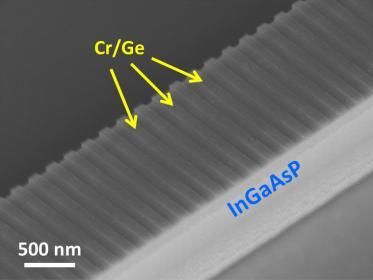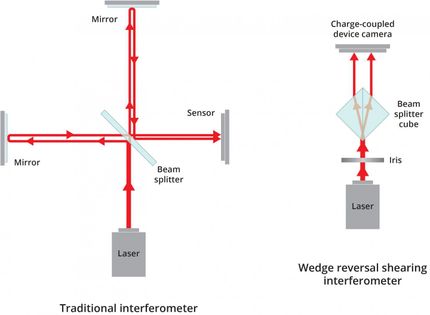New Microscope Chemically Identifies Micron-Sized Particles
Researchers have developed a microscope that can chemically identify individual micron-sized particles. The new approach could one day be used in airports or other high-security venues as a highly sensitive and low-cost way to rapidly screen people for microscopic amounts of potentially dangerous materials.
Researchers from the Massachusetts Institute of Technology’s Lincoln Laboratory, USA, demonstrated their new microscope by measuring infrared spectra of individual 3-micron spheres made of silica or acrylic. The new technique uses a simple optical setup consisting of compact components that will allow the instrument to be miniaturized into a portable device about the size of a shoebox.
“The most important advantage of our new technique is its highly sensitive, yet remarkably simple design,” said Ryan Sullenberger, associate staff at MIT Lincoln Labs and first author of the paper. “It provides new opportunities for nondestructive chemical analysis while paving the way towards ultra-sensitive and more compact instrumentation."
The microscope’s ability to identify individual particles could make it useful for fast detection of chemical threats or controlled substances. Its high sensitivity is also ideal for scientific analysis of very small samples or for measuring the optical properties of materials.
Probing spectral fingerprints
Infrared spectroscopy is typically used to identify unknown materials because almost every material can be identified by its unique infrared absorption spectrum, or fingerprint. The new method detects this infrared fingerprint without using infrared detectors. These detectors add significant bulk to traditional instruments which is limiting for portable devices because of their requirement for cooling.
The new technique works by illuminating particles with both an infrared laser and a green laser. The infrared laser deposits energy into the particles, causing them to heat up and expand. The green laser light is then scattered by these heated particles. A visible-wavelength camera is used to monitor this scattering, tracking physical changes of the individual particles through the microscope’s lens.
The instrument can be used to identify the material composition of individual particles by tuning the infrared laser to different wavelengths and collecting the visible scattered light at each wavelength. The slight heating of the particles doesn’t impart any permanent changes to the material, making the technique ideal for non-destructive analysis.
The ability to excite particles with infrared light and then look at their scattering with visible wavelengths – a process called photothermal modulation of Mie scattering – has been used since the 1980s. This new work uses more advanced optical components to create and detect the Mie scattering and is the first to use an imaging configuration to detect multiple species of particles.
“We're actually imaging the area that we're interrogating,” said Alexander Stolyarov, technical staff and a co-author of the paper. “This means we can simultaneously probe multiple particles on the surface at the same time.”
The new microscope’s use of visible wavelengths for imaging gives it a spatial resolution of around 1 micron, compared to the roughly 10-micron resolution of traditional infrared spectroscopy methods. This increased resolution allows the new technique to distinguish and identify individual particles that are extremely small and close together.
“If there are two very different particles in the field of view, we’re able to identify each of them,” said Stolyarov. “This would never be possible with a conventional infrared technique because the image would be indistinguishable.”
Compact, tunable infrared laser
The development of compact, tunable quantum cascade infrared lasers was a key enabling technology for the new technique. The researchers combined a quantum cascade laser with a very stable visible laser source and a commercially available scientific-grade camera.
“We are hoping to see an improvement in high-power wavelength-tunable quantum cascade lasers,” said Sullenberger. “A more powerful infrared laser enables us to interrogate larger areas in the same amount of time, allowing more particles to be probed simultaneously.”
The researchers plan to test their microscope on additional materials, including particles that are not spherical in shape. They also want to test their setup in more realistic environments that might contain interferents in the form of particles that aren’t from the chemical of interest.
“The presence of interferents is perhaps the biggest challenge I anticipate we will need to overcome,” said Stolyarov. “Although contamination is a problem for any technique measuring absorption from small amounts of materials, I think our technique can solve that problem because of its ability to probe one particle at a time.”
Original publication
Other news from the department science
Most read news
More news from our other portals
See the theme worlds for related content
Topic World Particle Analysis
Particle analysis methods allow us to study tiny particles in various materials and reveal their properties. Whether in environmental monitoring, nanotechnology or the pharmaceutical industry, particle analysis gives us a glimpse into a hidden world where we can decipher the composition, size and shape of particles. Experience the fascinating world of particle analysis!

Topic World Particle Analysis
Particle analysis methods allow us to study tiny particles in various materials and reveal their properties. Whether in environmental monitoring, nanotechnology or the pharmaceutical industry, particle analysis gives us a glimpse into a hidden world where we can decipher the composition, size and shape of particles. Experience the fascinating world of particle analysis!



























































